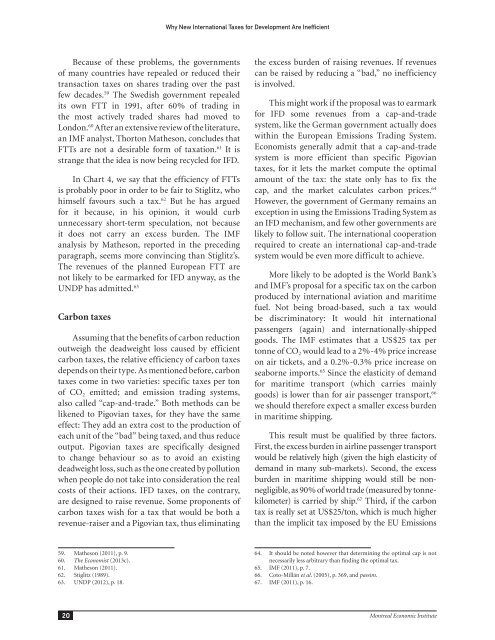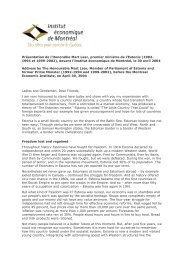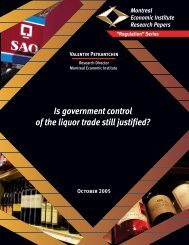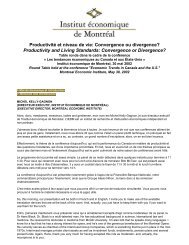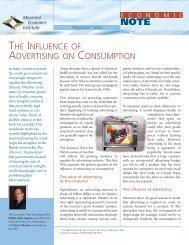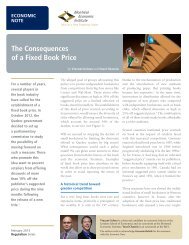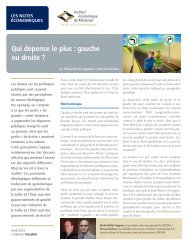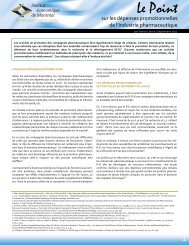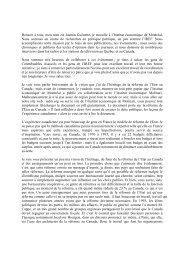Publication (PDF format) - Institut économique de Montréal
Publication (PDF format) - Institut économique de Montréal
Publication (PDF format) - Institut économique de Montréal
You also want an ePaper? Increase the reach of your titles
YUMPU automatically turns print PDFs into web optimized ePapers that Google loves.
Why New International Taxes for Development Are InefficientBecause of these problems, the governmentsof many countries have repealed or reduced theirtransaction taxes on shares trading over the pastfew <strong>de</strong>ca<strong>de</strong>s. 59 The Swedish government repealedits own FTT in 1991, after 60% of trading inthe most actively tra<strong>de</strong>d shares had moved toLondon. 60 After an extensive review of the literature,an IMF analyst, Thorton Matheson, conclu<strong>de</strong>s thatFTTs are not a <strong>de</strong>sirable form of taxation. 61 It isstrange that the i<strong>de</strong>a is now being recycled for IFD.In Chart 4, we say that the efficiency of FTTsis probably poor in or<strong>de</strong>r to be fair to Stiglitz, whohimself favours such a tax. 62 But he has arguedfor it because, in his opinion, it would curbunnecessary short-term speculation, not becauseit does not carry an excess bur<strong>de</strong>n. The IMFanalysis by Matheson, reported in the precedingparagraph, seems more convincing than Stiglitz’s.The revenues of the planned European FTT arenot likely to be earmarked for IFD anyway, as theUNDP has admitted. 63Carbon taxesAssuming that the benefits of carbon reductionoutweigh the <strong>de</strong>adweight loss caused by efficientcarbon taxes, the relative efficiency of carbon taxes<strong>de</strong>pends on their type. As mentioned before, carbontaxes come in two varieties: specific taxes per tonof CO 2 emitted; and emission trading systems,also called “cap-and-tra<strong>de</strong>.” Both methods can belikened to Pigovian taxes, for they have the sameeffect: They add an extra cost to the production ofeach unit of the “bad” being taxed, and thus reduceoutput. Pigovian taxes are specifically <strong>de</strong>signedto change behaviour so as to avoid an existing<strong>de</strong>adweight loss, such as the one created by pollutionwhen people do not take into consi<strong>de</strong>ration the realcosts of their actions. IFD taxes, on the contrary,are <strong>de</strong>signed to raise revenue. Some proponents ofcarbon taxes wish for a tax that would be both arevenue-raiser and a Pigovian tax, thus eliminatingthe excess bur<strong>de</strong>n of raising revenues. If revenuescan be raised by reducing a “bad,” no inefficiencyis involved.This might work if the proposal was to earmarkfor IFD some revenues from a cap-and-tra<strong>de</strong>system, like the German government actually doeswithin the European Emissions Trading System.Economists generally admit that a cap-and-tra<strong>de</strong>system is more efficient than specific Pigoviantaxes, for it lets the market compute the optimalamount of the tax: the state only has to fix thecap, and the market calculates carbon prices. 64However, the government of Germany remains anexception in using the Emissions Trading System asan IFD mechanism, and few other governments arelikely to follow suit. The international cooperationrequired to create an international cap-and-tra<strong>de</strong>system would be even more difficult to achieve.More likely to be adopted is the World Bank’sand IMF’s proposal for a specific tax on the carbonproduced by international aviation and maritimefuel. Not being broad-based, such a tax wouldbe discriminatory: It would hit internationalpassengers (again) and internationally-shippedgoods. The IMF estimates that a US$25 tax pertonne of CO 2 would lead to a 2%-4% price increaseon air tickets, and a 0.2%-0.3% price increase onseaborne imports. 65 Since the elasticity of <strong>de</strong>mandfor maritime transport (which carries mainlygoods) is lower than for air passenger transport, 66we should therefore expect a smaller excess bur<strong>de</strong>nin maritime shipping.This result must be qualified by three factors.First, the excess bur<strong>de</strong>n in airline passenger transportwould be relatively high (given the high elasticity of<strong>de</strong>mand in many sub-markets). Second, the excessbur<strong>de</strong>n in maritime shipping would still be nonnegligible,as 90% of world tra<strong>de</strong> (measured by tonnekilometer)is carried by ship. 67 Third, if the carbontax is really set at US$25/ton, which is much higherthan the implicit tax imposed by the EU Emissions59. Matheson (2011), p. 9.60. The Economist (2013c).61. Matheson (2011).62. Stiglitz (1989).63. UNDP (2012), p. 18.64. It should be noted however that <strong>de</strong>termining the optimal cap is notnecessarily less arbitrary than finding the optimal tax.65. IMF (2011), p. 7.66. Coto-Millán et al. (2005), p. 369, and passim.67. IMF (2011), p. 16.20Montreal Economic <strong>Institut</strong>e


